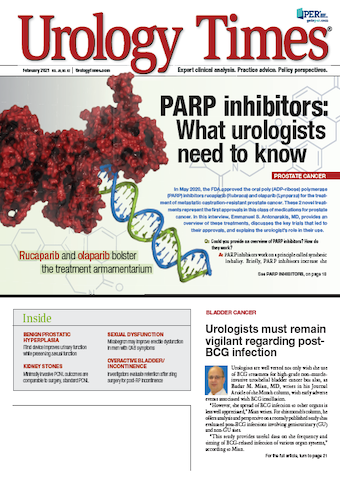Publication
Article
Urology Times Journal
Focal radiation boost improves outcomes in prostate cancer
Author(s):
The boost improved biochemical disease-free survival without negatively affecting safety and quality of life.
Adding an extra dose of external-beam radiation therapy (EBRT) to the standard EBRT improved biochemical disease-free survival (bDFS) in patients with localized prostate cancer, according to findings from the phase 3 FLAME study published in the Journal of Clinical Oncology.1,2
The focal boost was delivered directly to the intraprostatic lesion visible on multiparametric magnetic resonance imaging (mpMRI). At 5 years, the bDFS rate was 92% with the focal boost compared to 85% with standard EBRT alone (HR, 0.45; P <.001).
The added bDFS came without negatively affecting safety and quality of life. The cumulative incidence of late genitourinary toxicity grade ≥2 was 23% with standard treatment versus 28% with the focal boost. The cumulative incidence of late gastrointestinal toxicity grade ≥2 was 12% versus 13%, respectively. Also, there were only small, statistically insignificant differences in health-related quality of life between the 2 arms.
“The radiation boost halved the percentage of men presenting with raised PSA levels over the first 5 years after treatment: from 15% to 8%,” radiation oncologist and research leader Linda Kerkmeijer, MD, of UMC Utrecht and Radboudumc, stated in a press release. “The radiation boost did not lead to additional side effects, which is an important outcome.”
Between 2009 and 2015, the single-blind FLAME (Focal Lesion Ablative Microboost in Prostate Cancer) study enrolled 571 men with localized intermediate- or high-risk prostate cancer. Patient characteristics were well balanced between the 2 study arms. Across the overall population, the mean age was 70 years.
Patients were randomized in a 1:1 ration to receive standard treatment alone (287 patients) or standard treatment plus the focal boost (284 patients). Standard treatment was conventionally fractionated EBRT comprising 77 Gy in 35 fractions of 2.2 Gy to the entire prostate.
The additional radiation in the experimental arm consisted of a simultaneously delivered integrated focal boost to the macroscopic tumor as visible on mpMRI. The boost was up to 95 Gy, comprising 35 fractions of up to 2.7 Gy. If necessary, investigators reduced the boost to comply with prespecified organs at risk (OAR) constraints.
The median follow-up time was 72 months. Five year bDFS was the primary end point. Secondary end points consisted of DFS, distant metastases-free survival, prostate cancer–specific survival, overall survival, toxicity, and health-related quality of life.
“Our results can benefit a substantial number of men,” radiation oncologist Floris Pos, MD, of the Netherlands Cancer Institute, stated in the press release. “Every year, in the Netherlands, we give radiation therapy to hundreds of men who may qualify for this treatment. This could prevent a lot of trouble: for our patients, cancer recurrence often means uncertainty, diagnostic examinations, and intense treatments like surgery or hormone therapy.”
References
1. Kerkmeijer LGW, Groen VH, Pos FJ, et al. Focal boost to the intraprostatic tumor in external beam radiotherapy for patients with localized prostate cancer: results from the FLAME randomized phase III trial [published online ahead of print January 20, 2021]. J Clin Oncol. 2021. doi: 10.1200/JCO.20.02873.
2. Radiation boost lowers risk of prostate cancer recurrence. Published online January 20, 2021. Accessed January 21, 2021. https://bit.ly/2KA6J54.

Newsletter
Stay current with the latest urology news and practice-changing insights — sign up now for the essential updates every urologist needs.
































